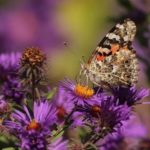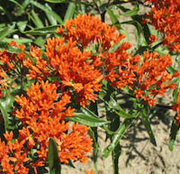Using more native plants in gardens and outdoor spaces is gaining in popularity for many reasons. These plants are suited to the local environment and require cold winter weather and spring melt water to thrive and reproduce. They can support a complex web of organisms, beneficial pollinators, insects, and plants as part of the overall environment. They require less effort since they do not need special arrangement like lifting bulbs or other protections to help them survive our winters. More nurseries are featuring native plants, making them easier to get.

Gardeners should continue to:
- Learn about the habits of plants and whether they suit the site.
Ambrosia artemisiifolia has a delightful name but Common Ragweed is responsible for hay fever and should be avoided. Anemone canadensis Canada Anemone is a hardy perennial with single white blooms in spring. It spreads by rhizomes and can take over a garden but in woodland settings this can be desired.
- Plan for a succession of blooms, foliage colours throughout the seasons.
While many native flowers are white, some plants have colourful flowers. These include: Rosa blanda Meadow Rose with pink flowers in spring and orange-red fruit and foliage later in the season; Lobelia cardinalis Cardinal Flower with scarlet-red flowers in summer; Lobelia siphilitica Great Blue Lobelia with clear blue flower spikes in summer; Asclepias tuberosa Butterfly Milkweed has orange blooms late summer; and Symphyotrichum novae-angliae New England Aster with purple flowers in the fall. Bold fall foliage is a feature of many maple, dogwood, sumac, serviceberry and other native shrubs and trees.

People should be willing to:
- Embrace more complex, naturalistic mixtures of plants.
Native plants can not thrive in beds with limited plant varieties interspersed among pavement, pavers, pools, and patios. A mixture of trees, shrubs, vines, perennials, and/or other plants is best to offer the shade, support, shelter and other needs of some plants and animals.
- Tolerate less perfection and neatness.
While the removal of weeds and preventive maintenance should continue, striving for perfection is not necessary. Plants can tolerate some holes and nibbles of some bugs and so should we. Rose leaves with holes carved by leafcutter bees should not result in the plants being discarded. Not chopping back plants in the fall can allow flowerheads to persist and offer food sources for birds, plus interest and muted colours to the winter landscape.
The move to native plants does not mean that all plants in a garden need be native. Some research indicates that when up to 30 percent of the plants are non-native, many other organisms can continue to flourish.
Some non-native plants can:
- Adapt to climate change and warmer, drier and/or more variable conditions.
Plants noted for their adaptability and ability to survive harsher or variable conditions are useful, such as many succulents and sedums. Plants from warmer, adjacent climatic zones might be better able to adjust to future changes.
- Tolerate urban conditions, some diseases or foreign pests and diseases.
Some plants are better able to tolerate salt in the environment or air pollution found in urban areas. Plant breeders have developed some varieties which resist a range of diseases, resulting in healthy plants without the use of chemical sprays. Plants which have developed a resistance to diseases and pests in their native habitat, such as Asiatic elms, have been used to replace some American elms which have been devastated by a disease originating in Asia.
- Reflect breeding for beautiful or adaptable varieties or treasured plants.
Plant breeders have been hybridizing plants and developing beautiful varieties with flowers and characteristics to tempt gardeners. They have also been developing plants adapted to the smaller spaces of many urban properties. Exotic plants offer challenges and appeals as well. With so many choices, it is hard to forego at least some non-native plants for the garden or replace long-standing non-native favourites.
People should not forget that some of the most valued creatures in our gardens were once non-natives, such as earthworms and European honeybees.
The trend to native plants makes a lot of sense in creating environmentally adapted, biologically diverse gardens. Be judicious and go with native plant choices if desired or go native … partly.